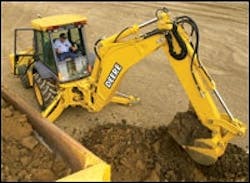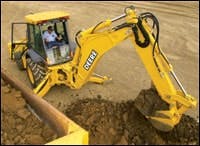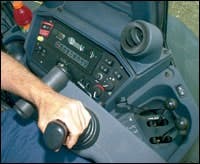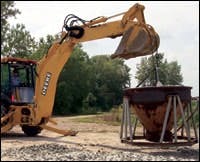Deere's 710G Blends Muscles and Manners
John Deere makes no small claims for its new 710G backhoe loader, available since the first of the year. The new machine, says the company, has the digging force and lift capacity of a 12-metric-ton hydraulic excavator, coupled with the loading ability of a 2-cubic-yard, four-wheel-drive wheel loader. Given these capabilities, Deere suggests that the John Deere 710G backhoe could significantly enhance productivity by replacing both a wheel loader and small excavator on jobsites using these machines in combination.
After spending a day in the dirt with the 710G, we'd say that Deere's "one-for-two-replacement" idea just might be feasible in some situations. What we know for a fact, though, is that this new machine is a brute and, according to Gene Held, our guest operator for this installment of Earthmoving Field Test, it's exceedingly capable at excavating, loading and lifting.
When we say "brute," we mean sheer physical size, power and capability. The John Deere 710G backhoe stands just 3 inches shy of 10 feet to the top of the cab, and it weighs in, typically equipped, at 26,500 pounds. It's powered by a big six-cylinder, 6.8-liter Deere diesel that's rated at 118 net horsepower and Tier-II compliant. With its standard dipperstick, it can dig to 17 feet and leave 8 feet of flat-bottom trench before repositioning. And its structural strength and auxiliary-hydraulic power are adequate for handling serious attachments, such as large hammers.
Test Set: John Deere 710G Backhoe-Loader
- Engine: Six-cylinder, 6.8-liter, Deere 6068 diesel, 118 hp (net) @ 2,200 rpm
- Transmission: Powershift 4F/3R, maximum forward speed 23 mph w/21L-24 rear and 14.5/75-6.1 front tires
- Final drives: Inboard planetary type
- Brakes: Inboard wet disc
- Typical operating weight: 26,500 pounds
- Maximum dig depth: 17 feet 10 inches with standard dipperstick, 22 feet 6 inches with extendible stick
- Reach from swing-pivot center: 22 feet 6 inches with standard dipperstick, 26 feet 8 inches with extendible stick
- Loader breakout force: 14,800 pounds with 1.87-cubic-yard bucket
- Options: Mechanical front-wheel drive, extendible dipperstick, cab, air conditioning, ride control, suspension seat, tilt steering
Says Held, an instructor for the past three years at the apprentice-training center (Plainfield, Ill.) for Local 150 of the International Union of Operating Engineers:
"The training staff was quite taken by the size of the 710G when it rolled off the trailer, and everyone wanted to get their hands on it. But I had first dibs."
Held, an excellent operator with 35 years experience—and a great sense of humor—was gracious enough to spend a day with Construction Equipment editors in evaluating the 710G from an operator's perspective.
When we met up with Held on the appointed day, he had already warmed the 710G's hydraulics by roading it around the Local's expansive, 150-acre complex.
"Some backhoes can really beat you up going down the road," he said, "but this one is easy on you, especially with that suspension seat and the ride-control. The machine has a lot of stability, it doesn't wobble, and it turns sharply. The cab is great—plenty of room, good visibility and very quiet. And you could hang meat in there with the A/C on. The transmission up-shifts smoothly, and I especially noticed the brakes—no chatter."
The suspension seat and the ride-control that Held so liked are options for the 710G, as is the 26,000-Btu/hr air conditioner that kept our machine cool as the day heated up. According to Deere, the 710G's ride also has been enhanced, compared to that of its 710D predecessor, by a completely new mainframe that provides better balance. The cab is new, with 14 percent more floor space and 30 percent more glass, and the ROPS posts and doors have been relocated for better visibility. And the brakes, a design carry-over from the 710D, are the hydraulic wet-disc type.
How well does the Deere 710G backhoe handle trenching?
During our initial evaluation, Held opened about 30 feet of trench, 8 feet deep, depositing spoil into a waiting 25-ton Volvo articulated truck. He then stopped to give his impressions.
"The first thing you notice with the backhoe is its power. This material has been pounded pretty hard by scraper traffic, so it's tough digging. But I found I could slide the throttle down to its economy setting and still work as fast as I wanted. I don't think the engine ever lugged down. And it's quiet in here; I didn't need my earplugs."
The digging power that Held noted comes from the John Deere 710G backhoe's new pressure-compensated, load-sensing hydraulic system, which exerts 4,000 pounds more bucket dig force than did the 710D. The added force is the combined result of higher system pressure (3,625 versus 2,550 psi) and larger-bore cylinders. The higher pressure also yields 72 percent more swing torque.
Our test machine was fitted with pilot-operated joystick controllers for the backhoe, mounted in the seat consoles. A rocker switch on the panel allows switching patterns between conventional backhoe type and excavator. The joysticks are standard, but if you prefer "wobble sticks" at your knees, they're available as an option.
"I like the joysticks," said Held, "because they eliminate the control-lever console between your feet, which means you can now pretty much look straight down into the trench. The joysticks and the smoothness of the hydraulic system let you feather into each function. No operator likes a jerky machine because it wears on you. If it's smooth, then you get into a rhythm—it makes for a better day."
At Held's suggestion, he next used the 710 to excavate a length of ditch, about 6 feet deep with gently sloping sides. The excavation could have been an OSHA-approved trench for storm-sewer. He piled the spoil along side.
"This machine has the size to dig a lot of ditch," he said. "Its stability when you're swinging is very good. It looks to me as if part of that comes from extending the center of the stabilizer pads past the center post."
(He's correct. Deere stretched the stabilizer spread 18 inches on the 710G, and also increased stabilizer down pressure 30 percent.)
Could you use the 710's backhoe to dig a basement? we asked.
"If you had to," he said, "but it would be slower than with an excavator, because you'd lose time with the extendible stick."
How well do you think it would pull a trench box?
"Depends," said Held, "on how deep the excavation is and the kind of material you're in. You're going to lose pulling power if you have to extend the stick in a deep trench or if the material is heavy and wet."
Overall, what stands out most about the 710's backhoe?
"Its hydraulic smoothness—it's outstanding. For an operator, the feel of the hydraulics is everything. I like to dig with the teeth at a 30- to 45-degree angle, at a depth about equal to the length of the teeth. That way, I can feel anything in the trench. This machine's hydraulic system makes that easy to do."
Held then spun the seat around and used the loader to fill the Volvo with material from a moderately compacted bank.
"You sit high in this machine, and it has lots of glass and a slanted hood for a good view of the bucket corners," he said. "Kicking material to the far side of the body was no problem, and I never had to wait for the hydraulics—it's very quick. I also like the single bucket cylinder Deere uses, because when you reposition while you're trenching, you can line up the cylinder with a target in the distance to keep the trench straight."
But what really impressed Held in the loading exercise was the 710's aggressive push into the bank. He subsequently took the machine to a small hill of material packed brick-hard by scrapers to test the limit of the machine's excavating capacity, alternately using the rear-axle differential lock.
"When I got into the really hard stuff, I expected the back tires to start hopping," he says, "and that I'd have to raise the bucket to get forward movement. But the machine just hunkered down and kept going with hardly any tire spin. It has a lot of power to the ground, and I couldn't stall it crowding the pile."
Held asked us what accounted for the 710's aggressive digging ability. We surmised that part of the answer was the efficiency of its new hydraulic system, which conserves horsepower when pumping hydraulic oil, thus freeing power for tractive effort. But a big contributor to 710G's tractive effort, says Deere, is the significant reshaping of the engine's torque curve, thanks to its electronic fuel-injection system.
Says Held, "If the tires aren't spinning, you can concentrate on loading the bucket."



